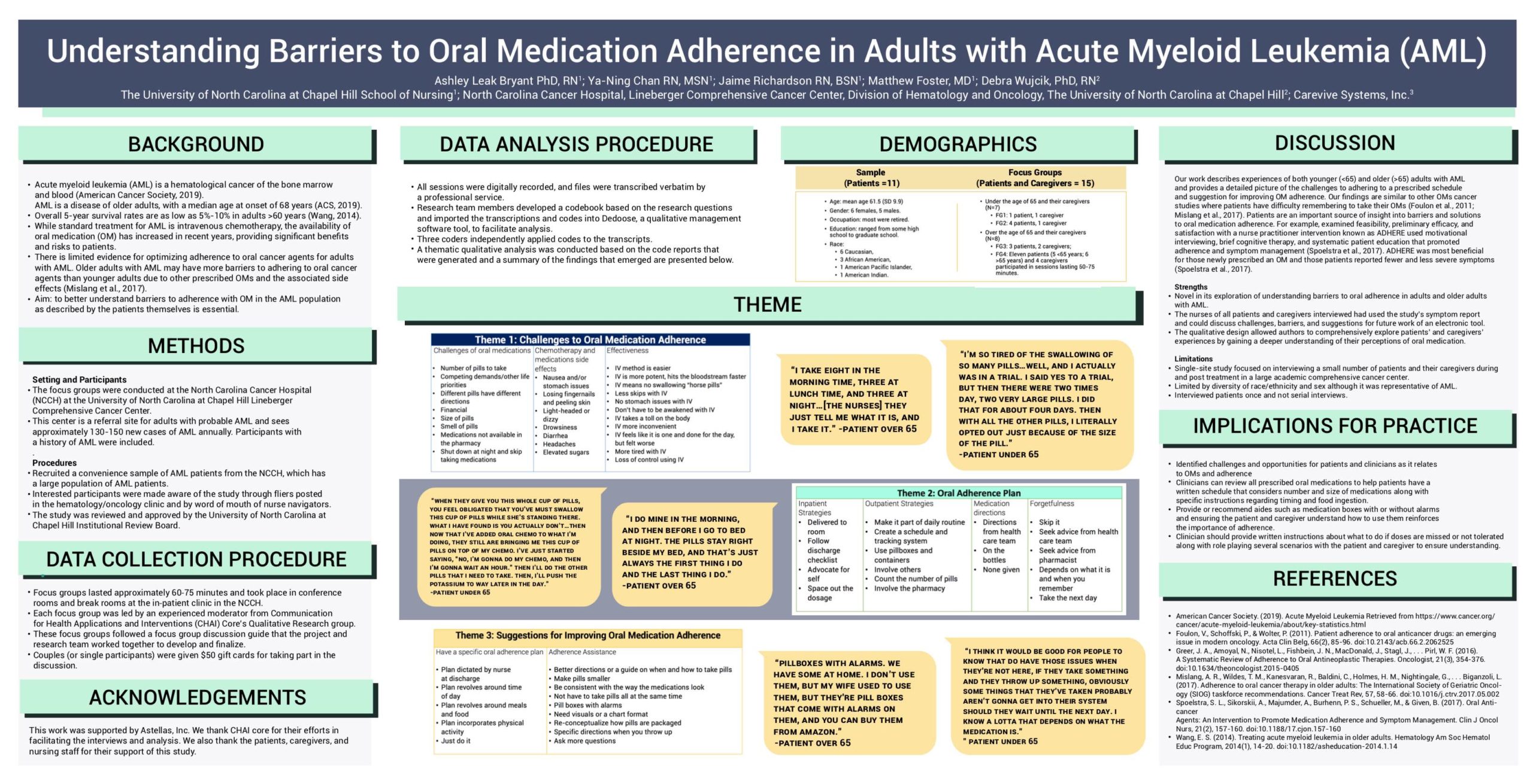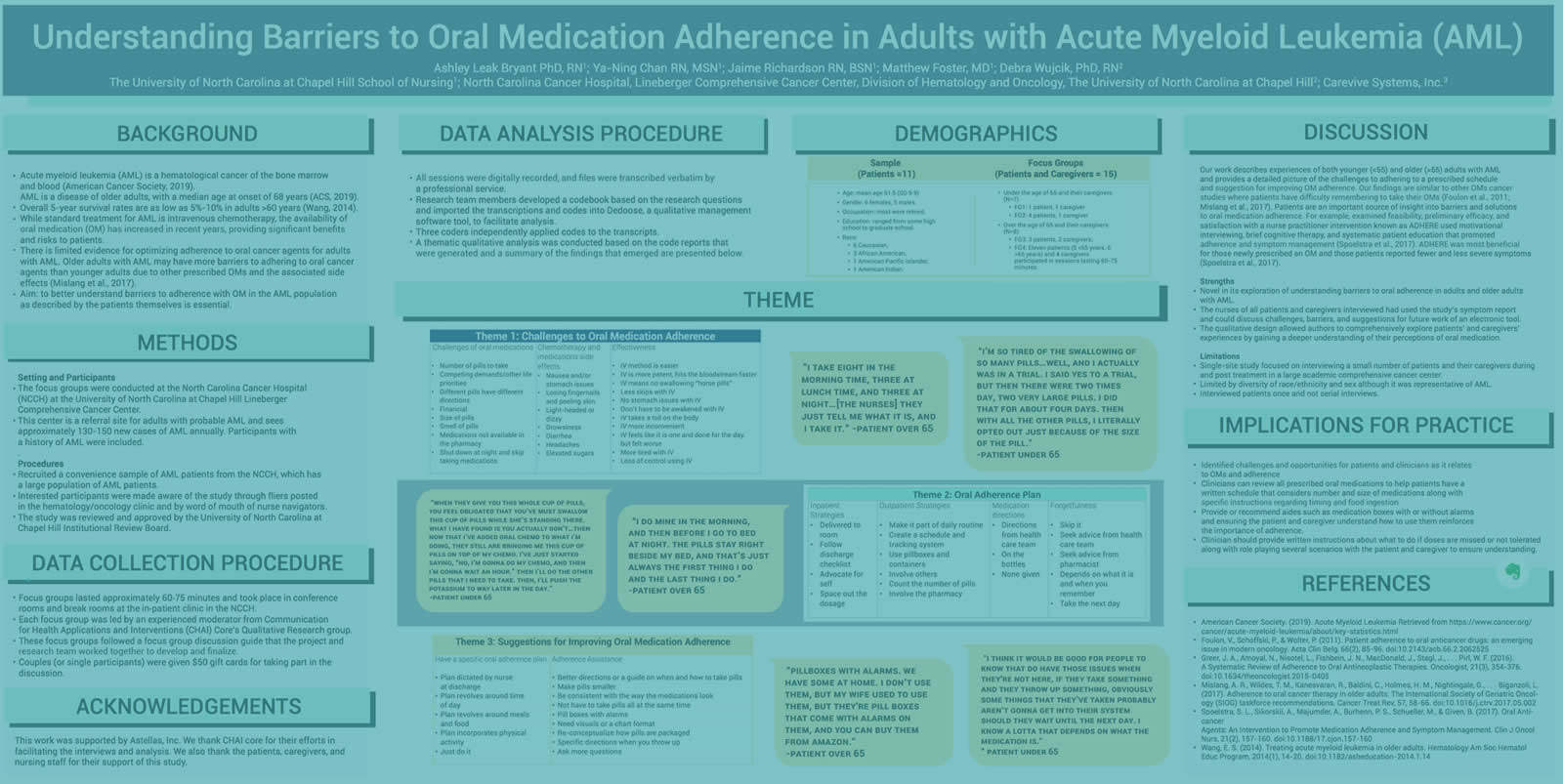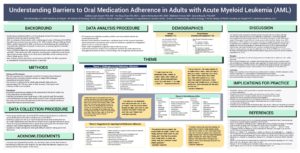
Authors: Ashley Leak Bryant PhD, RN1 ; Ya-Ning Chan RN, MSN1 ; Jaime Richardson RN, BSN1; Matthew Foster, MD1 ; Debra Wujcik, PhD, RN2
1 The University of North Carolina at Chapel Hill School of Nursing;
2 North Carolina Cancer Hospital, Lineberger Comprehensive Cancer Center, Division of Hematology and Oncology, The University of North Carolina at Chapel Hill
3 Carevive Systems, Inc
Background
- Acute myeloid leukemia (AML) is a hematological cancer of the bone marrow and blood (American Cancer Society, 2019). AML is a disease of older adults, with a median age at onset of 68 years (ACS, 2019).
- Overall 5-year survival rates are as low as 5%-10% in adults >60 years (Wang, 2014). While standard treatment for AML is intravenous chemotherapy, the availability of oral medication (OM) has increased in recent years, providing significant benefits and risks to patients.
- There is limited evidence for optimizing adherence to oral cancer agents for adults with AML. Older adults with AML may have more barriers to adhering to oral cancer agents than younger adults due to other prescribed OMs and the associated side effects (Mislang et al., 2017).
- Aim: to better understand barriers to adherence with OM in the AML population as described by the patients themselves is essential.
Methods
Setting and Participants
- The focus groups were conducted at the North Carolina Cancer Hospital (NCCH) at the University of North Carolina at Chapel Hill Lineberger Comprehensive Cancer Center.
- This center is a referral site for adults with probable AML and sees approximately 130-150 new cases of AML annually. Participants with a history of AML were included.
Procedures
- Recruited a convenience sample of AML patients from the NCCH, which has a large population of AML patients.
- Interested participants were made aware of the study through fliers posted in the hematology/oncology clinic and by word of mouth of nurse navigators.
- The study was reviewed and approved by the University of North Carolina at Chapel Hill Institutional Review Board
Discussion
Our work describes experiences of both younger (<65) and older (>65) adults with AML and provides a detailed picture of the challenges to adhering to a prescribed schedule and suggestion for improving OM adherence. Our findings are similar to other OMs cancer studies where patients have difficulty remembering to take their OMs (Foulon et al., 2011; Mislang et al., 2017). Patients are an important source of insight into barriers and solutions to oral medication adherence. For example, examined feasibility, preliminary efficacy, and satisfaction with a nurse practitioner intervention known as ADHERE used motivational interviewing, brief cognitive therapy, and systematic patient education that promoted adherence and symptom management (Spoelstra et al., 2017). ADHERE was most beneficial for those newly prescribed an OM and those patients reported fewer and less severe symptoms (Spoelstra et al., 2017).
Strengths
Novel in its exploration of understanding barriers to oral adherence in adults and older adults with AML. The nurses of all patients and caregivers interviewed had used the study’s symptom report and could discuss challenges, barriers, and suggestions for future work of an electronic tool. The qualitative design allowed authors to comprehensively explore patients’ and caregivers’ experiences by gaining a deeper understanding of their perceptions of oral medication.
Limitations
Single-site study focused on interviewing a small number of patients and their caregivers during and post treatment in a large academic comprehensive cancer center. Limited by diversity of race/ethnicity and sex although it was representative of AML. Interviewed patients once and not serial interviews.




